Keyword Research is crucial to filling your Content Calendar. This research helps you find topics to write about that are related to your niche. It also allows you to drive the correct kind and quantity of traffic to your blog.
I want to share some of the best tips I have found in my blogging experiment. I hope that they will help you be a success. Grab some coffee ☕️, and let’s get into it!
Pssst… This is one of the jobs you should outsource at some point. Check my Outsourcing Guide for jobs you can and should outsource.
What is a Content Calendar? And its benefits?
Have you ever wished that you knew what you were going to write about before you had to write it?
What if you knew the title of your next article? How about the keywords you should focus on? Or what about the day you should release it?
There is good news! Those are some of the problems a Content Calendar solves!
As a quick note, a Content Calendar is similar to an Editorial Calendar. In fact, an editorial calendar is part of a complete content calendar. It is merely part of everything your team needs to create content successfully.
It is a schedule that keeps your creation on track. Each piece of content described on the calendar will provide everything you or your team need to write content for your blog. Also, there are plenty of content calendar templates for download online.
There are several benefits to having a Content Calendar planned with Keyword Research. Let’s explore some of them.
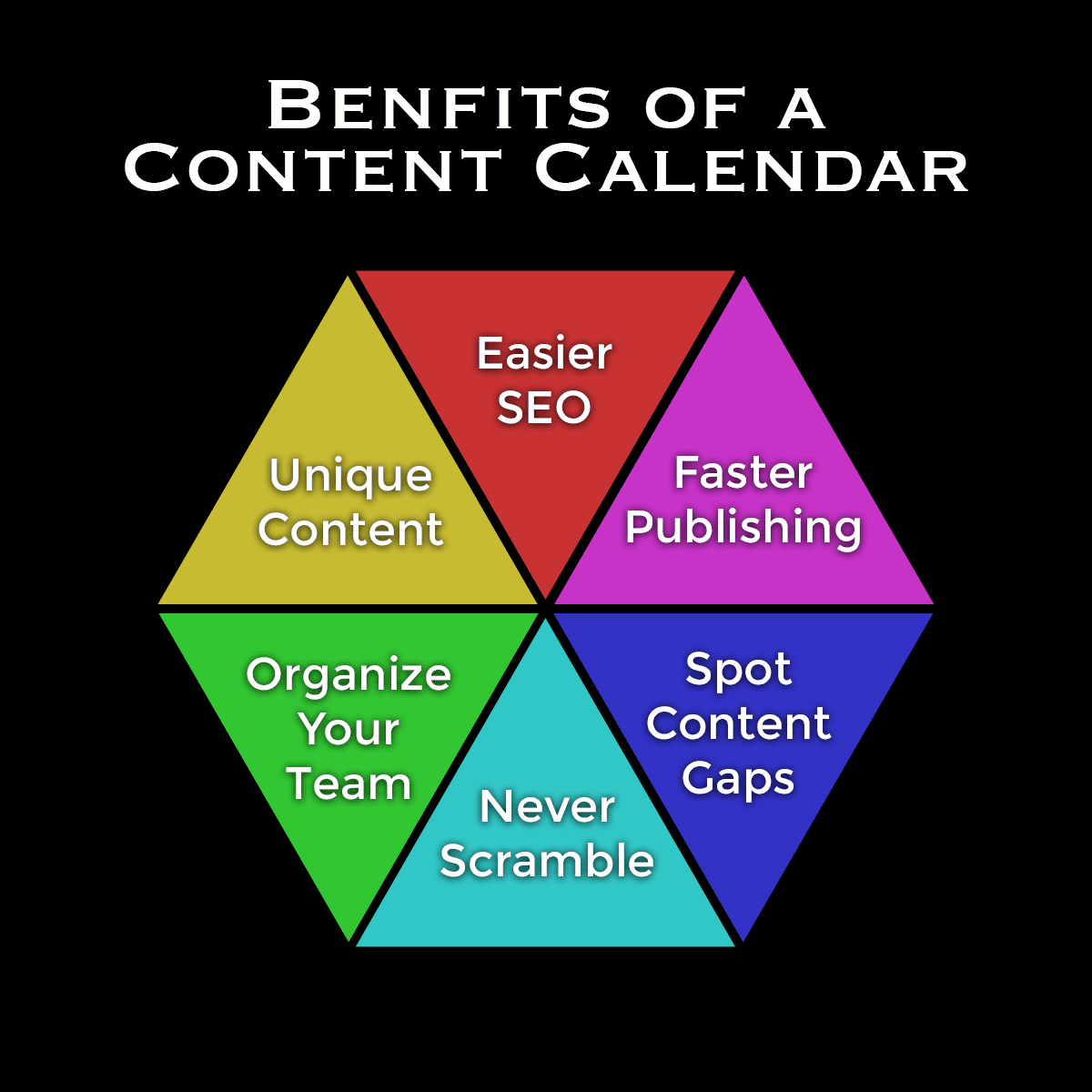
Never scramble for topics
We have all been there! You understand staying relevant with Google. It requires a constant flow of new content related to your niche.
Yet every time you go to write that next piece or have your team write it there are problems. You are plagued with last-minute research tasks. Those tasks ultimately delay that new content from coming out on time.
You scramble to determine the content gap you need to fill with this new article. The pressure makes you rush your “gap research.” This impacts the benefits you might see from filling that gap.
You struggle to meet your release deadline even after trying to find a topic. Maybe you start cutting corners in your writing. In the end, the blog post comes out as lower quality. You also miss out on some of the benefits it would have given your blog if it had been given the proper time.
The content creation part is not the only job. You require an SEO sweep. Do this to ensure you target keywords that will help draw eyes to your blog. Understanding the user’s search intent when choosing the keywords is crucial.
Images are needed to bring your article to life. This requires design efforts. We know images help because Google tells us they give us more SERP chances.
There might be editing and fact-checking that need to happen before your new content goes public. How about the backlinks in the post that link to affiliate offers that generate income?
With a content calendar, time is planned for each meaningful task.
With a content plan, the initial research needed to find the topic and keyword ideas is already done. This work was done without a time crunch. Therefore the quality and accuracy are top-notch.
An effort was also put in to develop a title. Maybe even the headings were prepared. Writing the content is as simple as making a few paragraphs for each key point.
Your SEO focus is handled ahead of time because of the Keyword Research. A second sweep on this takes almost no time.
Your design lead can create infographics for you while the article is written. This is because the key points are already laid out. Fact-checking can be done in tandem with writing.
Editing will be a cinch because the content’s topic data is already planned, like an editorial calendar. The most profitable affiliate links will already be researched. They can be easily added as a last-minute touch-up.
Frantic scrambling becomes a thing of the past. You or your team are prepared with all the data you need to create content perfectly. Your content plan, outlined on your content calendar, guides you to the perfect content.
Everyone knows what tasks they are working on. They also know the topics for those tasks. Also, the timeline is clear.
Your whole operation runs like a well-oiled machine! You can spend your time working on other essential parts of your blog, like a Sales Funnel.
Pssst… If you want more details about making a Sales Funnel, check out my guide to Sales Funnels. There are some great tips in there and some other helpful links.
Ease your SEO strategy
By doing your Keyword Research ahead of time, your SEO sweeps become a cinch. The SEO expert on your team will complete their tasks with less time crunch. They will have everything they need upfront to optimize those search queries for maximum exposure.
Usually, this yields better-quality keyword ideas with more in-depth research. Usually, this means you will get more gains from the work long-term.
Either way, your search query targeting will better attract your target audience since your SEO expert does not feel rushed. Instead, they will have more time to focus on other crucial search term gains. For instance, search intent for your target audience since it directs more active users.
With your SEO tasks done more thoroughly, your overall SEO strategy will be able to flourish. Other components of a complete SEO content plan will get more attention. This will allow your overall SEO strategy to provide more benefit to your blog and each blog post.
Complete SEO strategies have many components that work together for the best results!
For instance, more focus can be placed on your audience and their search intent. Extra attention can be given to the crucial parts of your Sales Funnel, like lead magnets. With your audience having higher purchase intent, you will undoubtedly generate more income.
More time can be spent reviewing your traffic, traffic sources, and general analytics. You can understand where your audience is coming from. You will know what they are looking for, where they are going, and how they interact with your content.
Usually, the extra focus here will optimize the user path through your Sales Funnel. As mentioned before, this could mean more income.
Time can be dedicated to Technical SEO:
- The structure & size of your pages.
- The schema information you provide to crawlers.
- The actual indexing & crawling process.
- Other highly technical parts of holistic SEO.
These items are all critical to reaching the top of the SERPs. Focusing on them will net gains in your search presence. It will also get you closer to your target audience.
Having a Keyword Research powered Content Calendar will enable this shift in focus for your SEO. It will guide you to a complete SEO content strategy. It can also lead to faster growth and more income.
Prevent duplicate content
Ideally, each new blog post should drive new audience members to your blog. Users want to find the info they seek without resistance or confusion. You can avoid this and potential frustration by not duplicating content. Focusing all your search query gains on active search intent is better.
As a quick note, this is only suited for your blog post content. Social media posts can have duplicate content. It also requires a different type of planning than your blog post content calendar.
I will have a relevant guide for this at some point in the future. For now, remember this is not for your social media posts.
With duplicate content, the SERPs for your pages might decrease, or you may stop ranking. Your target audience wants to be directed to the content they need. They can get frustrated and possibly even stop trusting you if they are not. In the best-case scenario, the user bounces from your site (usually, this is bad).
A worst-case scenario could be a user so mad that they report your blog to the search engine. This could lead to delisting. A high bounce rate lowers your SERPs, meaning less traffic.
Duplicate content can damage your domain authority and user rapport.
Domain authority can also be impacted. Flooding your blog with the same content will make it confusing. Search Engines will not be able to understand which page is the correct resource.
This also confuses your potential backlinkers. They might not know which of your many pieces of content should be linked.
With a Content Calendar, preventing duplicate content is easy. You will have a complete record right in your content calendar template.
You will know which content was published. It will show you what keywords were used. The record will also show when it was published.
When planning future content: you can reference this list of topics and keywords. This will help you avoid any overlap between blog posts.
Having a calendar will enable you to bypass the “duplicate content” trap. It will also help you reach more new target audience members. It will even help cover several related topics for the same target audience.
Increase publishing frequency
You may see improved creation speed and publishing frequency with a Content Calendar. Doing Keyword Research ahead of time makes the various tasks on your blog run smoothly. The people doing the work might manage their time more efficiently because they know what to work on.
With the team moving faster, you can see higher productivity and higher-quality work. Less ad-hoc requests will be required for each team member to make progress. Fewer interruptions mean more focused work time.
More focus usually results in a faster pace of work and better work. Either result can be a big boon for the growth of your blog.
Solid content generated at a faster pace will increase your visibility on SERPs.
Search engines weight publishing time as a high-ranking factor for some types of content. Blog posts produced more recently will usually have a higher ranking in the results. Therefore, to gain higher SERPs, publishing more often will get the most bang for your buck. With a small team, that might be impossible without a Content Calendar or enough Keyword Research.
Spot content gaps faster
Content Gaps are missed opportunities for your blog. A gap usually means plenty of users search for topics related to your blog. Sometimes, they may not be directed to it because you are not ranking for their search terms. With a Content Calendar, you can more easily spot these gaps!
As mentioned before, you can have a list that can be referenced during all phases of your blog. All it requires is this calendar be done correctly. It contains all the titles and keywords you have used in the past. This list of seed keywords will make finding similar search terms simple.
Filling Content Gaps can drive more qualified audience members to your blog.
Throw some of these seed keywords into the Ahrefs Keyword Generator tool. It will help you to find more potential topics to write about. Each new keyword idea could give you access to more customers looking for products like yours.
With more eyes on your blog, there is more opportunity to sell a high-value item to the masses. This means more potential income. That is good for you!
Organize your team
A Content Calendar helps you organize your team. Your team should be able to glance at the calendar and quickly understand. Tasks they have today and in the coming days should be clear in a moment. Typically, you will not have to micromanage them because they have line items they can use to stay on task.
Teams stay on task when they can reference a Content Calendar for scheduling.
The highest productivity hits come from employees who lack direction or those given under-specified tasks. With Keyword Research built into your Content Calendar, you can solve both problems.
Employees will know what to work on. They will also have all the information they need to do that work. They will spend less time flailing and more time working.
Pssst… Whether you outsource your writing or do it yourself, you still need a writing tool to help make the content the best. Check out my suggestion of the best writing tool out there.
An organized team will produce higher-quality work. That next-level content will raise your blog to the top of SERPs. Having higher SERPs means more traffic for your blog. An increase in visitors means you have higher income potential!
9+ Keyword Research tips for a Content Calendar
Starting my blog has been a learning experience. My research has included several different sources. Each of them gave me a new tip to incorporate into my workflow.
With the melting pot of data, I now know several tips I wish I had known from the start. I truly believe these tips can help most people who run a blog, and I hope they help you too! With this knowledge, we can all join the keyword elite.
Let’s start with some places to find keyword ideas.
1. Keyword Research: Wikipedia
When most experts suggest where to find keywords, there is a helpful source that most skip. Wikipedia is an excellent free keyword tool that is already organized for humans to read! The best part is it contains tons of content ideas too!
Think about it for a moment. When you read a page on Wikipedia, it usually covers one broad topic. Now think about how that page is organized.
Near the top of the content is a Table of Contents (TOC). This is what guides most readers to the part of the page they care about the most.
Look at the TOC, and you will see several “focus topics.” Each is directly related to the main topic. Each has a sub-heading with its own mini-page embedded below. Guess what?
Those sub-headings can sometimes be keywords!
Each heading might be about a related point to the main topic. It can also be focus material for a specific part of the main topic.
Both of those topic types qualify as excellent bonus keywords. Moreover, each heading might have a link to another page focused on that related topic. In that linked article, there might be more sub-headings that could be used as keywords!
Let’s see an example of the “Physics” page on Wikipedia.
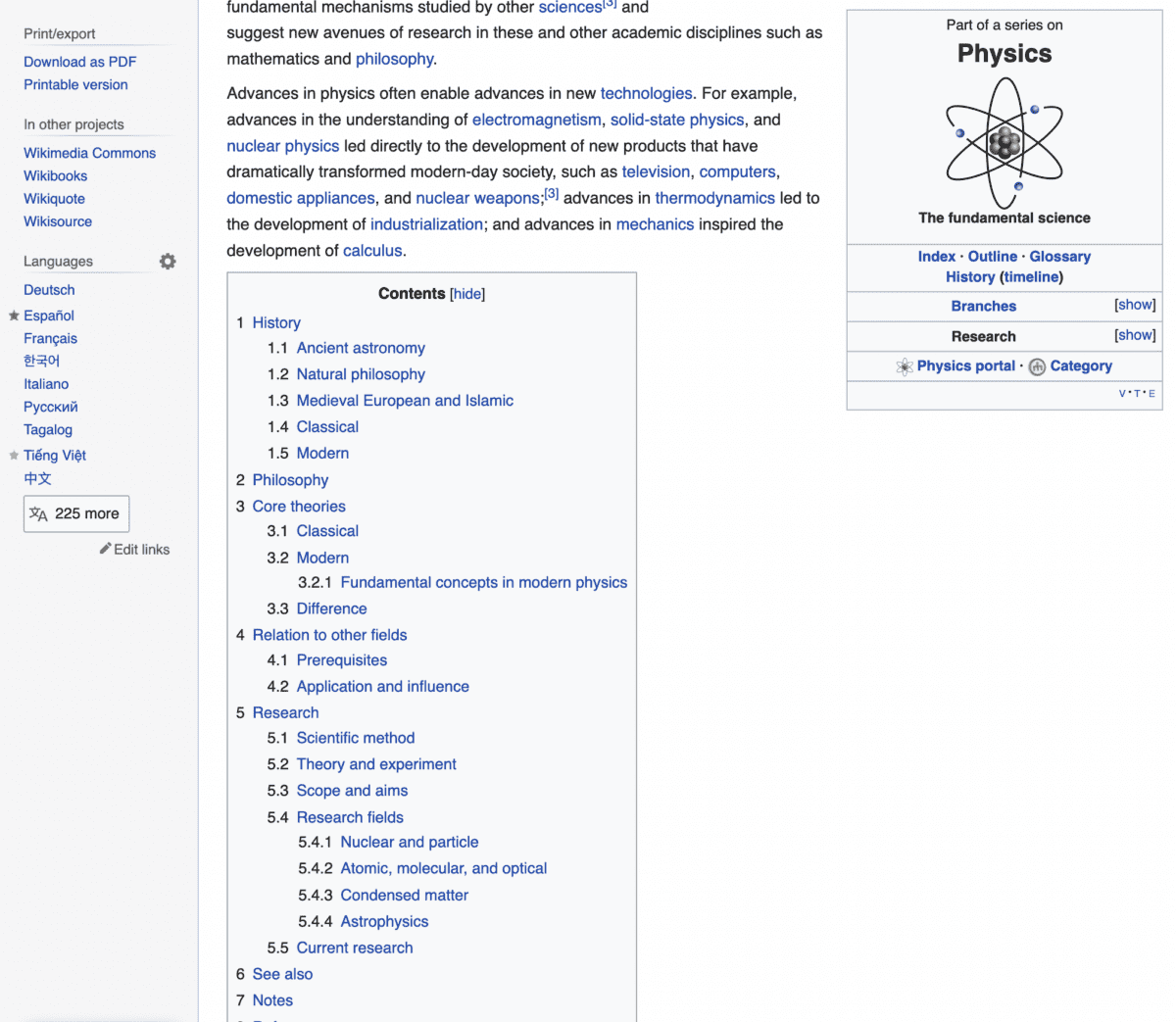
Looking at the TOC here, we can see several associated topics! Items #1.1 – #1.5 are all eras of Physics. These could easily be converted into related keywords.
Under #5, each of those headings is a beginner physics topic. Under #5.4, there is even a list of branches of Physics! These are all excellent keywords!
This same method can be used for almost any topic out there. Try to type your niche topic into Wikipedia. More than likely, you will find some related keywords this way. I bet you do!
2. Keyword Research: Related searches (Google)
I have been searching on Google since it was launched. There have been tons of different versions of the results pages since then. Recently, I read a tip I had not thought about. This tip can land you in the keywords elite category for sure!
Use Google results pages to get more relevant keywords.
As it turns out, this is a pretty FIRE way to find quality keywords and content ideas for your Content Calendar! In fact, it is one of the best content marketing and free keyword research tools out there!
This keyword tool comes directly from Google. That means it is one of the most crucial free keyword research tools available!
Google politely tells you other similar keywords that people are already searching for!
These keywords are found at the bottom of the first page. They look like “chips,” each with a related keyword having search traffic. Look at this screenshot for an example:
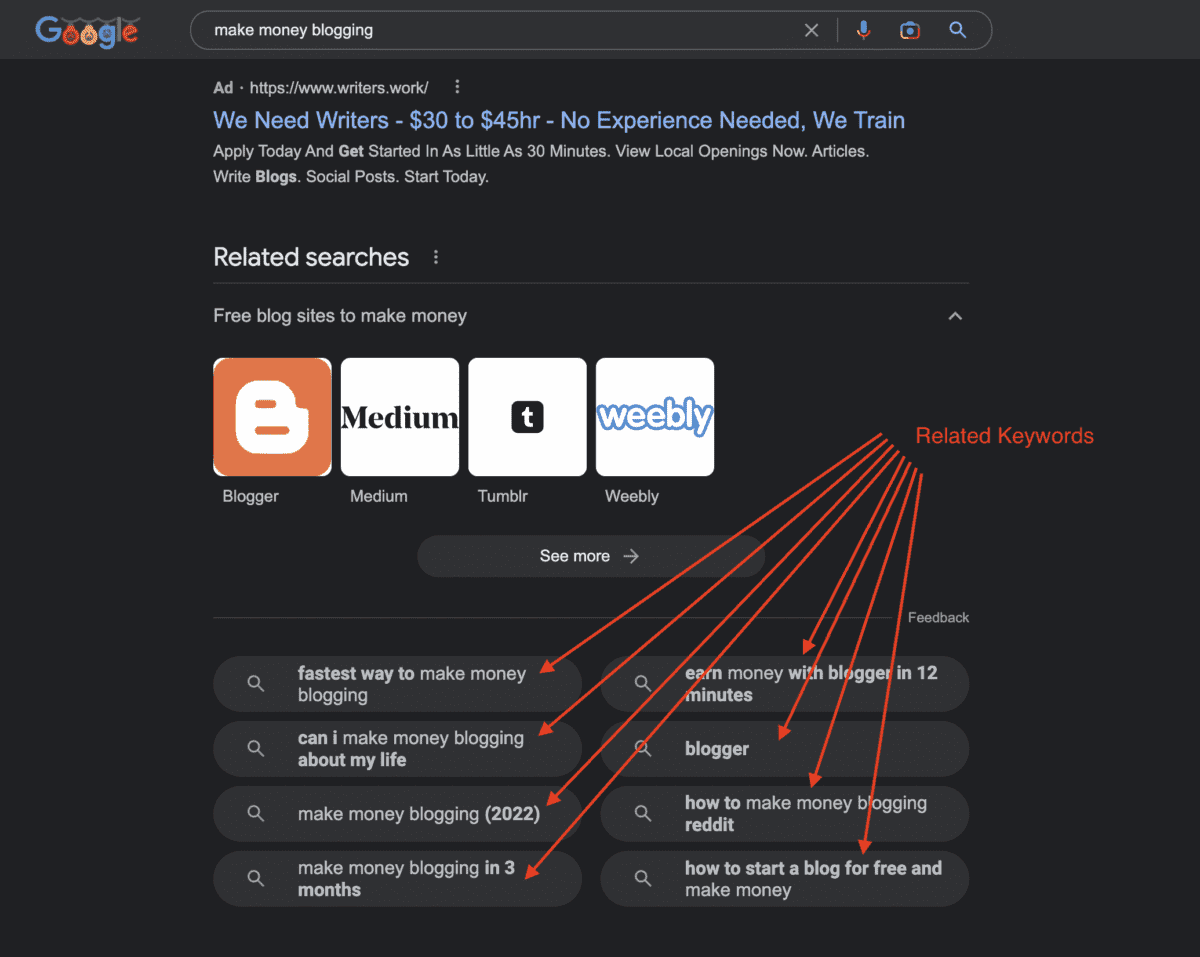
As you can see, there are several strong keywords here! Pick the ones you think relate to your content and add them to the calendar. Each one deserves more content focus. Real people search for them.
These suggested searches usually mean more target audience members could be sent to your blog. Leverage them to level up your traffic!
Pro-Tip: You can even take each of these, put them back into Google, and find more related keywords! Try this for several layers deep to build out an entire keyword tree. This one tip could build out your keyword list with only a few minutes of effort!
3. Keyword Research: GSC high-impression, low-click
If you have not signed up yet, I highly recommend starting your Google Search Console (GSC) account! It is free and gives you a direct communication line with Google. Truly this is an elite keyword research tool!
You can glean valuable info from this keyword tool. This can raise your blog to the upper tier of search results. Importantly, it can tell you which of your keywords are ranking. It can also give some general stats around those rankings.
Using these stats, you can identify new keywords that deserve their own content!
That’s right! Google tells you, for free, which keywords rank your pages already. It even tells the ones you did not specifically focus on! You can use these to build out your Content Calendar!
The list is comprehensive, possibly containing thousands of keywords for which you rank. To get the most use out of this list, you will want to identify a specific group of these keywords.
Find the keywords in the list with a low click-through rate and a high number of impressions. When you see this pattern in the numbers, it is time to start looking a little closer.
Usually, this means your content is high-quality. It typically also means your content is ranking, just not ranking on the first page of results.
This is your chance to improve! Writing content focused on this keyword will raise your rank even faster! Let’s look at an example!
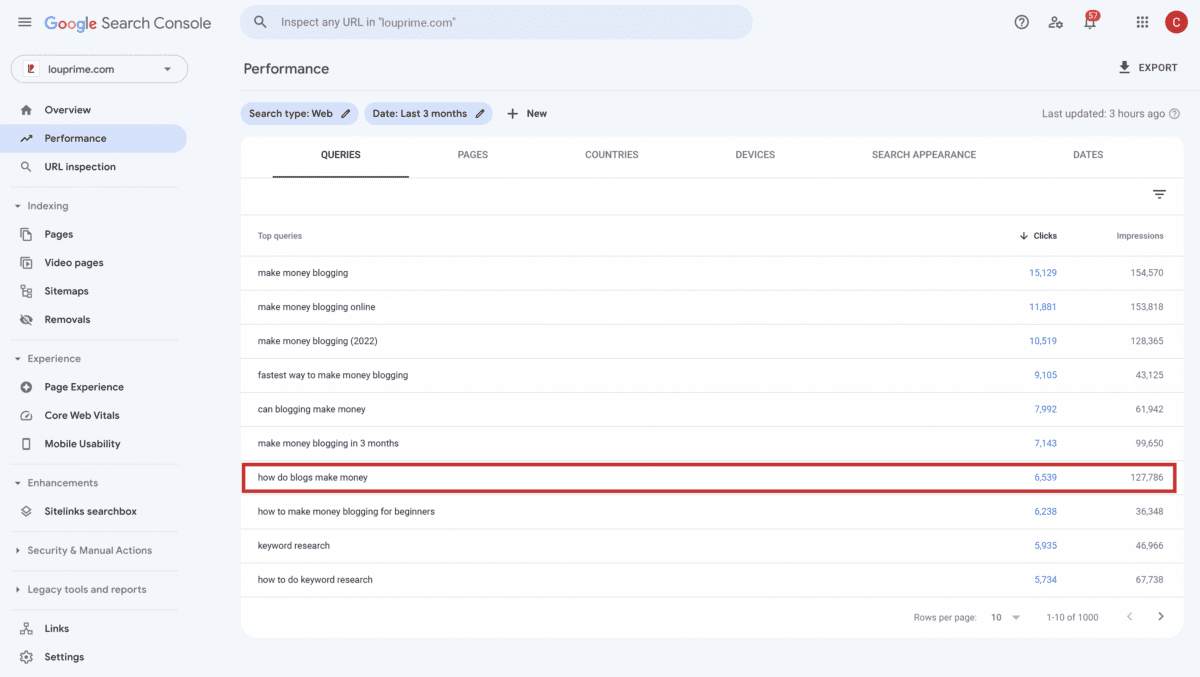
First, look at all of the numbers. Let’s create our own way to view this data. I take the clicks number and divide it by the impressions number. This gives the CTR, or click-through rate.
Many of them seem to be higher than 10% CTR. These keywords are probably first-page ranked. However, if you look at the highlighted one, it comes out to less than 5%.
This, on the other hand, is not first-page ranked. As new content is written using the focus keyword “how do blogs make money,” the rank for that keyword will skyrocket faster.
When I started using this keyword tool, it was amazing to see how quickly I could list keywords to use. Each item on the list still needed its typical Keyword Research. I still had to rank them from most valuable to least.
But this tip cut down my Keyword Research time significantly. Also, I strongly encourage you to explore GSC if you have not already! It has so many powerful tools for seeing how Google views your site.
4. High-value keywords first
So you have done your Keyword Research. You are almost ready to plug them into a Content Calendar. Great! What’s next?
Sort your keywords and focus content around the highest-value ones first!
To do this, we need to figure out how to rank the keywords so they can be sorted. Ranking them depends on your personal preference and your goals. I will share part of my strategy so you can get an idea of how to do this.
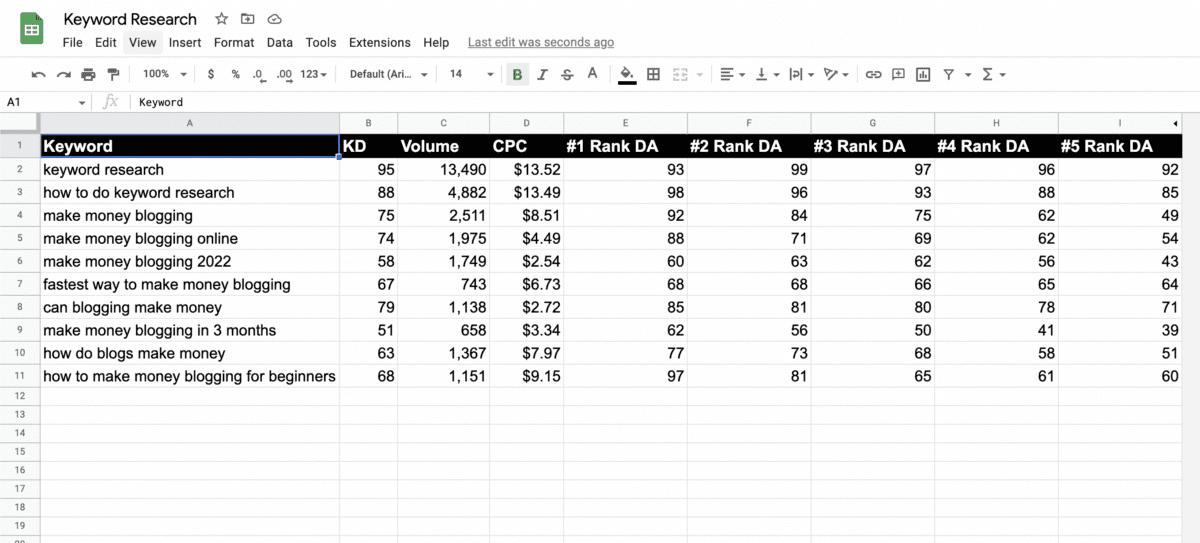
This is an example of initial Keyword Research. Here is a quick breakdown of each column:
- Keyword – The phrase to use for a keyword in new content.
- KD – The “Keyword Difficulty” as reported by Ahrefs and other sites.
- Volume – The number of monthly searches for that keyword.
- CPC – The top value for ads on those searches, as shown by Google Keyword Planner.
- #1-5 Rank DA – The top 5 position Domain Authority rank, reported by Ahrefs.
These columns show the bare basic info you should be tracking for each keyword. Many other values exist which could help your rank system, but each of these columns should have at least some impact on your decision. For my blog, I take these numbers (mixed with a few others) and use math to find a Rank for each.
Here are some things I consider in my formula:
- Lower KD usually means it will be easier to rank.
- The lower the average of the Top 5 ranked sites, the better.
- A higher volume means more traffic, which can be a bonus.
- However, a lower volume means that the users I do get are probably more likely to be active.
- A higher CPC means other advertisers think users will pay for a product, which is better for me.
Turning that into a formula is a bit harder. I find that breaking it down into smaller pieces makes it easier to work through. Here is a possible fully broken down formula:
avg_top_rank = SUM(E2:I2) / 5
kd_divisor = IF(OR(E2 <= 50, F2 <= 50, G2 <= 50, H2 <= 50, I2 <= 50), 100, 50)
base_points = 10,000
kd_weight = (50 - (avg_top_rank - 50)) / kd_divisor
volume_weight = MIN(C2/7000, 1)
cpc_weight = MIN(D2/10, 1)
rank = base_points * kd_weight * (volume_weight + cpc_weight)
complete_formula:
=7000 * ((50-((SUM(E2:I2)/5)-50))/IF(OR(E2<=50,F2<=50,G2<=50,H2<=50,I2<=50), 50, 100)) * (MIN(C2/7000, 1) + MIN(D2/10, 1))A lot going on, so let’s break it down:
- avg_top_rank – This is the average DA for #1-5 Rank DA values (columns e-i).
- kd_divisor – A KD less than or equal to 50 should get a boost. If at least one top-5 has a DA of less than 50, the rank will be twice as high.
- base_points – I give all keywords 10k starting points.
- kd_weight – This calculation uses kd_divisor in a ratio that favors lower KD keywords.
- volume_weight – Volume matters but only up to 7k visits. Anything more means nothing.
- cpc_weight – Higher CPC can mean higher paying customers. More than $10 is overkill.
- rank – This calculates the final Rank value. Lower volume mixed with higher CPC is good for me.
- complete_formula – A copy-paste version of this formula for Google Sheets.
Please remember, this is an example. It is similar to the one that works for me. Your factors will likely be different. Maybe you do not put as much stock in CPC value and want it to affect your ranking differently.
Or perhaps you want your volume to be uncapped. Some readers might even think the current top rankers do not matter at all. Feel free to change this to find your perfect rank system.
Once you have that ranking, it is time to sort your list. Remember, you should rank them from the best score to the worst. Google Sheets allows you to sort the sheet by any column easily. Here is what my example looks like after sorting:
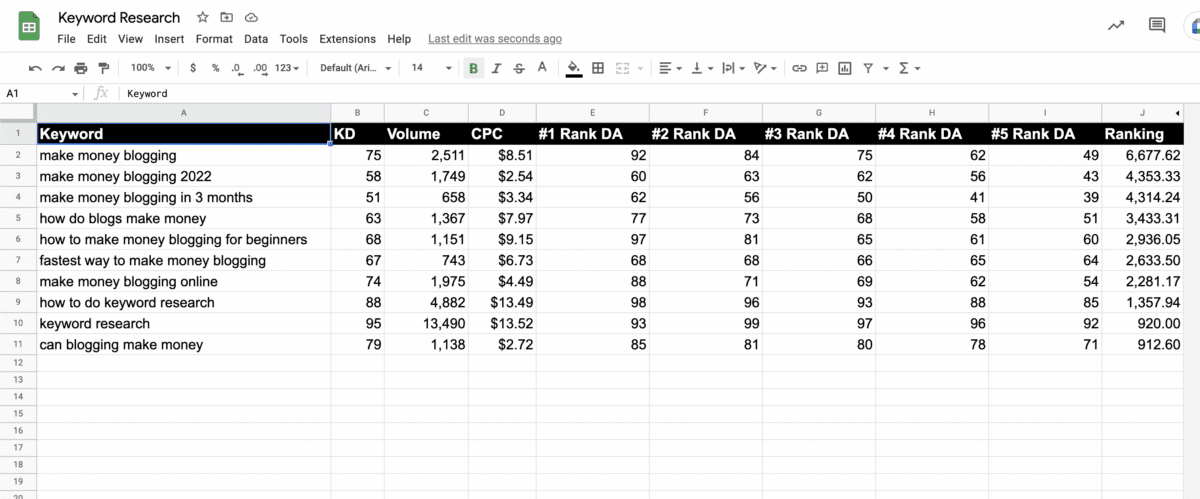
Keywords near the top should be earlier on your Content Calendar. Lower keywords should be later.
This example Keyword Research only has ten potential keywords. Yours should probably have more than 100. Ideally, you would make a Content Calendar for six months.
Regardless you should figure out how to rate each keyword’s value. You could use a ranking as described above. Focus on the highest-ranking keywords first. They will have the most impact on your blog.
5. Track relevant data on the calendar
I have read many of the Content Calendar articles out there. Most of these blog posts tell you to do Keyword Research. Then add an entry on your Content Calendar for the day you want to publish the content.
However, you can get more out of your calendar if you put more into it. I like to call this one the Google Calendar Keyword Tracker tip. What does this mean?
Your Content Calendar should provide everything your team needs.
Adding as much info as you can to the Content Calendar keeps your team working at a high speed. All of your content ideas are in one place, so you and your team are super organized. Here are the things I suggest putting on it:
- The Focus Keyword and the Secondary Keyword to write the blog post around.
- A strong SEO title and URL. I like to use Rank Math for this.
- Create a Google Doc with a detailed heading list. Add the link to the Content Calendar.
- Be clear about how many words you expect the blog post to have.
- Write the number of internal and external links you expect the article to have.
- Make a time slot for the end time for each of these:
- Mark when writing should be done.
- Mark when the infographic design should be done.
- Mark when editing the article should be done.
- Mark when the last pass of an SEO audit should be done.
- If you have a large team, make each time slot have the team member’s name.
- Write down contact info for any needed external contacts, like experts or guests.
The idea is to ensure your team has what they need for the blog post ahead of time. By doing this, you enable them to work quickly but efficiently. They can move fast but keep a high quality of work. Here is an example of a Content Calendar that uses this guide:
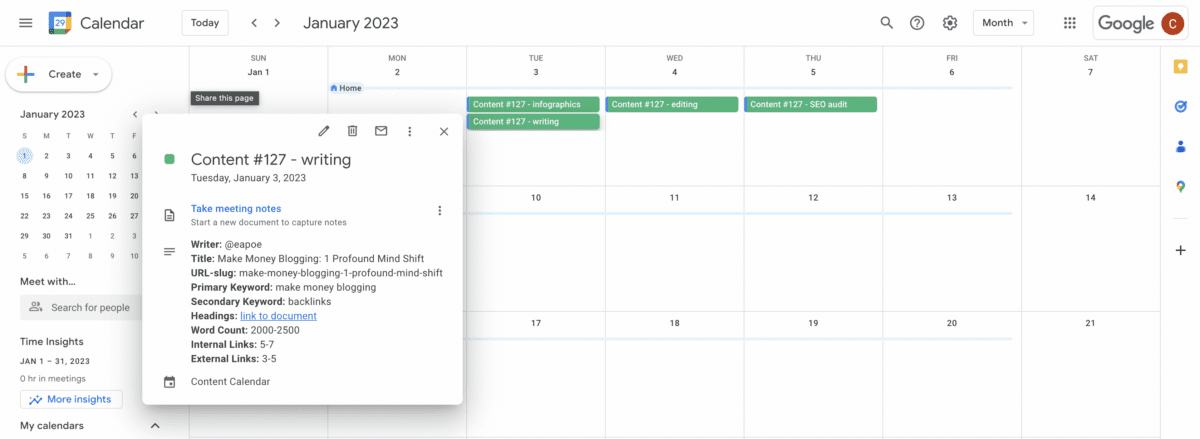
Notice that each item has the same color. Each also has the same prefix, “Content #127 -” before the job name. Each job has its end date. Even two different jobs share an end date.
Clicking on each item brings up the details page. The details have vital info about the article which we discussed earlier. We can see the “writing” item belongs to @eapoe. Each task for this blog post has its owner.
In this example, I use Google Calendar. There are many tools for creating a Content Calendar (note to self: make a post about the best tools). There is also plenty of content calendar templates for download. Read about them and try them if you like.
My example is only meant to show that even common, free tools can be used. As long as you can add all the vital info, whichever app you choose should work.
6. Have team meetings
Imagine you have a great team. Everyone is at the top of their field. Their skill levels mean they work fast and accurately. Yet they always seem to struggle completing tasks on time.
Most say they feel out of the loop on the timeline when you talk to them. Each also says they often think they have more time than they do. Some say they cannot find the info they need to finish their tasks.
That was me at more than one past job. You can solve this through open communication. A good start is putting as much info as you can on your Content Calendar, as I said earlier in #5.
Another good step is to have team meetings often so everyone is on the same page. You could also invest a little bit of money into a company chat app like Slack.
The most important thing is to communicate.
Ensure that all team members know what they are working on. Also, ensure team members who rely on each other’s work can coordinate to unblock each other. Promote communication on the team, and there will more than likely be a productivity increase.
My teams usually prefer a weekly Zoom meeting and daily chat updates. This offers a balance between communication and productivity time.
Too many meetings can be bad. Having them sparingly is a good policy. Nobody likes a micromanager.
7. Quality > Quantity
One or Two well-written, link-rich, infographic-filled, SEO-focused blog posts a week are preferred. Not ten grammatically incorrect, anchor-less, image-barren, keyword-less articles. Google wants to promote content that users find helpful.
Google wants your content to link to other content. They want it to contain info related to your keywords. It should also have graphical info in the form of pictures and have incoming links from other sites.
Google wants your backlink profile to be full of top-notch high-authority domains that link to your blog post. The quality of the backlinks in your backlink profile is of vital importance.
On the other hand, users want to see content they can read. When you have poorly written, low-quality content, users feel like they cannot trust you. Without user trust, there will be fewer incoming links and fewer incoming users.
It is equally important to impress your users as compared to impressing Google.
Please remember, those people will be your customers. Customers interact with people they trust. Trust is what keeps loyal customers too.
Build that trust through quality content, accurate info, and valuable products that solve problems. Build a community that people like enough to tell others about.
8. Audit your calendar monthly
A Content Calendar is meant to be a guide and a rough schedule to keep everyone on track. It also needs to be flexible.
Life is happening all around us. Things change daily. Because of this, your Content Calendar is more like a living document. It should be able to change.
Anything can change in six months!
Maybe a new software is made public, making some of your planned content outdated. What if a world event happened that affected your niche at its core? Perhaps you found some new keywords that relate to your content. Maybe someone made an invention that creates a new branch for your content.
Even if none of these things happen, your Content Calendar deserves an audit. There could be new topics out there for your content. You will never know about those ideas unless you focus time on an audit.
9. Have evergreen content on-deck
No Content Calendar is complete without backup content. Teams are made up of humans. Humans have lives, and nobody’s life is perfect.
The unexpected happens more often than we care to admit. When it does, your Content Calendar timeline can fall behind.
Your team might miss some delivery dates. Your users might complain because they expect new content to be published often. Without people working on the content, there is no way you can make anything new. Or can you?
The most important thing is to keep some backup content ready to publish.
Always have some backup, evergreen content ready to publish. It will ensure you can continue to release content, even while issues hurt your team. I have seen this keep users engaged time and time again.
Of course, the evergreen content should relate to your niche. It still needs to have the same high-quality writing and infographics. It still needs proper Keyword Research.
Having content on deck for release is vital to keeping a stream of new content for your users to consume. Users grow to expect new content, especially if they enjoy it. Keeping them engaged is crucial to push them down your Sales Funnel. The more hooked they are, the more income they will create for you.
Your turn
We reviewed the benefits you can reap from creating a Content Calendar. We talked about why using solid Keyword Research as a foundation is crucial. I shared some tips that could ease the pains of creating that calendar. You might have also learned how to keep your team productive.
Combine these tips with your other knowledge to give you the upper hand on your blog. Gains in SERP rankings and traffic could be earned by using these tips. What will you do next? The choice is yours!

